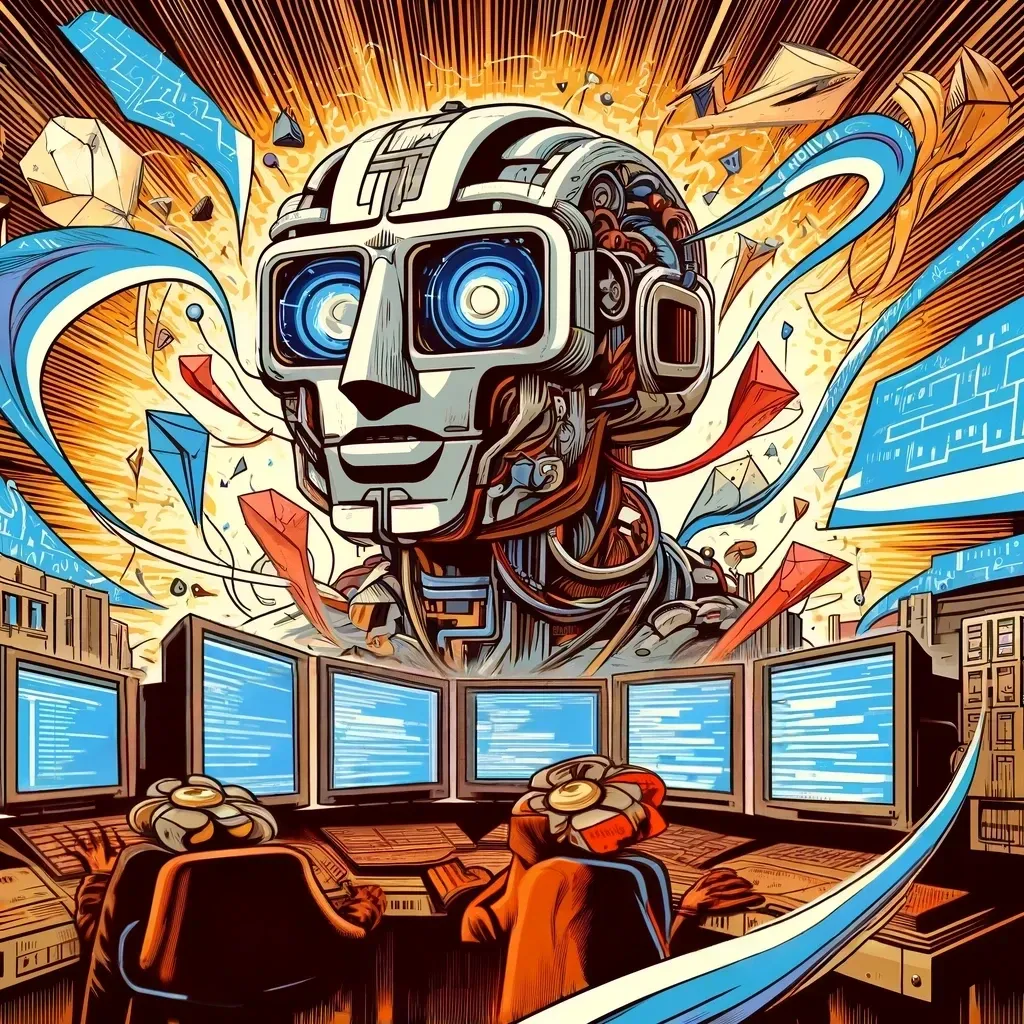Before we dive in: I share practical insights like this weekly. Join developers and founders getting my newsletter with real solutions to engineering and business challenges.
The world of software development is on the cusp of a paradigm shift. As Large Language Models like GPT continue to evolve, we're witnessing a fascinating phenomenon: the ability to offload traditionally hard-coded logic to these AI-driven systems. Imagine a future where entire programs spring to life from mere prompts, where the rigid constraints of statically typed languages give way to the fluid, adaptive nature of AI-driven code. It's a future that's closer than we might think.
The non-deterministic nature of LLMs might raise eyebrows among software engineers, but as these models become more sophisticated and controllable, they open up possibilities that were once science fiction. We're not just talking about AI assistants that help write code; we're envisioning AI systems that make complex software decisions, query databases, and even route HTTP requests - all in real-time.
In this article, we'll explore LLM integration in software development. We'll push the boundaries of what's possible, examining how far we can abstract our software logic and what it could mean for the future of our industry. Buckle up - we're about to venture into uncharted territory in the AI-driven software revolution.
Current State of LLMs in Software
The integration of LLMs into software development is already well underway. Today, we're seeing these assist developers in numerous ways:
- Code Completion and Generation: Tools like GitHub Copilot use LLMs to suggest code snippets and even entire functions based on context and comments.
- Natural Language to Code Translation: Developers can describe functionality in plain English, and LLMs can generate corresponding code.
- Code Explanation and Documentation: LLMs can analyse existing codebases and generate human-readable explanations or documentation.
- Bug Detection and Fixing: Some systems use LLMs to identify potential bugs in code and suggest fixes.
- API Integration: LLMs are being used to understand API documentation and suggest appropriate usage in code.
However, these applications are just the start. The real excitement lies in how LLMs are beginning to handle more complex decision-making processes within software systems. For instance, some applications are using LLMs to:
- Choose appropriate functions based on a given task and a list of available functions.
- Generate database queries based on natural language descriptions.
- Assist in system architecture decisions by analysing requirements and suggesting optimal structures.
These advancements hint at a future where LLMs play an even more integral role in software development and execution. But how far can we push this integration?
Abstracting Decision-Making to LLMs
The real power of LLMs in software development lies not just in assisting developers, but in taking on more complex decision-making processes traditionally handled by hard-coded logic. This shift represents a fundamental change in how we approach software architecture and development.
Instead of explicitly coding conditional logic, we could present an LLM with a task description and a list of available functions. The LLM could then decide which function(s) to call, in what order, and with what parameters. This approach could lead to more flexible and adaptable systems, capable of handling edge cases that developers might not have anticipated.
LLMs could analyse user behaviour, preferences, and context in real-time to dynamically adjust UI elements, creating truly personalised user experiences without the need for extensive pre-programmed rules.
Rather than relying on predefined error messages and recovery procedures, an LLM could analyse the context of an error, suggest potential fixes, and even implement the most appropriate solution automatically.
LLMs could continuously analyse codebases, identifying areas for improvement and suggesting or even implementing refactoring to enhance performance, readability, and maintainability.
By understanding the broader context of a system's operation, LLMs could make nuanced decisions about security measures, adjusting permissions and access controls based on complex, real-world factors that go beyond simple rule-based systems.
The key advantage of abstracting these decisions to LLMs is the potential for software to become more adaptable and intelligent. Instead of being constrained by the foresight and logic of its original programmers, software could evolve and respond to new situations in ways that mimic human problem-solving.
However, this approach is not without challenges. The non-deterministic nature of LLMs means that their decisions might not always be predictable or easily explainable. Ensuring consistency, reliability, and accountability in LLM-driven decision-making processes will be crucial as we push further in this direction.
As we continue to explore this frontier, the question becomes: how far can we take this abstraction?
Pushing the Boundaries: Radical Ideas
Let's push our thinking to the absolute limit: imagine a future where traditional coding as we know it ceases to exist. A future where every aspect of software creation and execution is handled by Large Language Models. This isn't just abstraction; it's a complete paradigm shift in how we conceive of software.
The Code-less Future:
LLM as the Operating System
Instead of a traditional OS, imagine an LLM that interprets user intentions and orchestrates all system operations. Need to open a file? Just ask. Want to connect to a network? The LLM handles it all, dynamically generating the necessary operations.
Natural Language Software Creation and Logic:
Forget IDEs and programming languages. In this future, the entire concept of software creation and logic implementation is transformed. Creating software is as simple as describing what you want in natural language, and the logic resides entirely within the LLMs through prompts.
Prompt-Based System Architecture:
Entire system architectures are defined through conversational prompts. For example:
"Create a high-availability e-commerce platform with AI-driven recommendations, blockchain-based payments, and GDPR compliance."
The LLM not only understands this request but can design the entire system architecture, considering factors like scalability, security, and regulatory requirements.
Logic as Conversation:
Complex business logic is implemented through ongoing dialogue with the LLM. Instead of writing functions or classes, developers (or even non-technical stakeholders) can explain processes in natural language:
"When a user adds an item to their cart, check inventory. If stock is low, offer a 5% discount on a related item."
The LLM interprets this, creates the necessary logical structures, and implements them within the system.
Iterative Refinement Through Dialogue:
As requirements evolve or issues arise, users can simply converse with the system:
"The discount isn't driving enough sales. Let's increase it to 10% for items over $50."
The LLM then adjusts its internal logic accordingly, without any traditional "coding" taking place.
Dynamic, Real-time System Adaptation:
Systems don't just run; they continuously evolve. The LLM constantly analyses performance, user behaviour, and external factors, rewriting its own operations in real-time to optimise for current conditions.
Universal Compatibility and Integration:
With LLMs handling all operations, the concept of APIs becomes obsolete. Any system can seamlessly interact with any other, with the LLM handling all translations and integrations on the fly.
Implications of a Code-less Future:
- Democratisation of Software Creation: Anyone with an idea could create complex software systems, potentially leading to an explosion of innovation but also raising questions about quality control and digital literacy.
- The End of Traditional Programming Roles: The role of software developers would transform dramatically, potentially focusing more on prompt engineering, system design, and ethical considerations rather than coding.
- Black Box Systems: With LLMs handling all operations, the inner workings of software systems could become increasingly opaque, raising concerns about accountability, debugging, and system understanding.
- Resource Intensity: Running everything through LLMs would require immense computational power, raising questions about energy consumption and hardware requirements.
- Security and Control: How do we secure systems that are constantly rewriting themselves? How do we maintain control over systems that operate at a level of complexity beyond human comprehension?
- Legal and Ethical Quandaries: Who's responsible when an LLM-driven system makes a critical error? How do we handle intellectual property in a world where software is generated from descriptions?
This code-less future represents both the ultimate abstraction of software development and a fundamental reimagining of what computing means. It's a future where the line between user and developer blurs, where software becomes a fluid, ever-changing entity shaped by intention rather than explicit instruction.
The Future of Software Development
The landscape of software development is poised for a radical transformation. Traditional coding may give way to prompt engineering, where developers guide AI systems through natural language interactions. This shift could democratise software creation, allowing individuals from all backgrounds to bring ideas to life without extensive programming knowledge.
We're likely to see dynamically evolving systems that adapt in real-time to changing requirements and user behaviours. Software could become a living entity, constantly optimizing itself and providing hyper-personalized experiences. The integration of knowledge from diverse fields may lead to innovative solutions that humans alone might not conceive.
The future will likely involve tight human-AI collaboration, with humans providing high-level direction and ethical oversight while AI handles complex implementation. This symbiosis could produce software systems of unprecedented sophistication. As AI takes a central role, we'll need to focus on ethical considerations, potentially creating new roles like AI ethicists and bias auditors.
Education in software engineering will evolve, emphasizing system design, prompt engineering, and AI collaboration techniques alongside ethical implications. We might even see the emergence of "meta-software" - AI systems designed to create other AI systems.
While challenges like AI control, transparency, and potential job displacement loom, the benefits far outweigh the downsides. We're looking at a future where software creation is faster and more accessible, capable of addressing complex problems with solutions drawing from the sum of human knowledge.
As we enter this new era, the question isn't whether this revolution will happen, but how we'll shape it to benefit humanity. The future of software is limited only by our imagination and our ability to guide these powerful AI systems towards positive ends.




